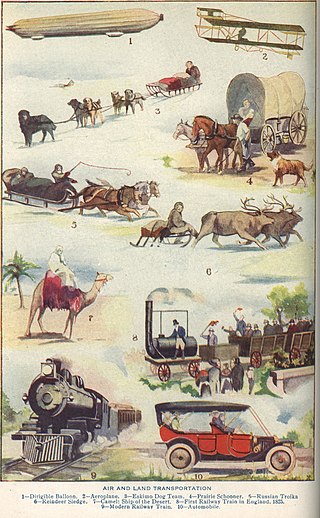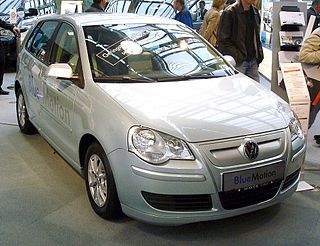
Fuel efficiency is a form of thermal efficiency, meaning the ratio of effort to result of a process that converts chemical potential energy contained in a carrier (fuel) into kinetic energy or work. Overall fuel efficiency may vary per device, which in turn may vary per application, and this spectrum of variance is often illustrated as a continuous energy profile. Non-transportation applications, such as industry, benefit from increased fuel efficiency, especially fossil fuel power plants or industries dealing with combustion, such as ammonia production during the Haber process.

The Honda Insight is a hybrid electric vehicle that is manufactured and marketed by Honda. Its first generation was a two-door, two passenger liftback (1999–2006) and in its second generation was a four-door, five passenger liftback (2009–2014). In its third generation, it became a four-door sedan (2018–2022). It was Honda's first model with Integrated Motor Assist system and the most fuel efficient gasoline-powered car available in the U.S. without plug-in capability — for the length of its production run.

The Volkswagen XL1 is a two-person limited production diesel-powered plug-in hybrid produced by Volkswagen. The XL1 car was designed to be able to travel 100 km on 1 litre of diesel, while being both roadworthy and practical. To achieve such economy, it was produced with lightweight materials, a streamlined body and an engine and transmission designed and tuned for economy. The concept car was modified first in 2009 as the L1 and again in 2011 as the XL1.

The Ford Fusion Hybrid is a gasoline-electric hybrid powered version of the mid-sized Ford Fusion sedan manufactured and marketed by Ford, now in its second generation. A plug-in hybrid version, the Ford Fusion Energi, was released in the U.S. in February 2013.

The Ford C-Max is a car produced by the Ford Motor Company from 2003 to 2019. It has a five-door compact multi-purpose vehicle (MPV) design. The Ford Grand C-Max has a longer wheelbase.
Gasoline gallon equivalent (GGE) or gasoline-equivalent gallon (GEG) is the amount of an alternative fuel it takes to equal the energy content of one liquid gallon of gasoline. GGE allows consumers to compare the energy content of competing fuels against a commonly known fuel, namely gasoline.

The SAE Supermileage Competition is a yearly fuel efficiency competition held at the Eaton Corporation proving grounds located in Marshall, Michigan, United States. The Society of Automotive Engineers is the primary sponsor. Around 30 teams compete to build the vehicle that uses the least amount of gas to go a specified distance. Teams are required to use a one cylinder lawnmower engine provided by Briggs & Stratton, but significant modification is allowed. There are two divisions, Collegiate and High School.

The fuel economy of an automobile relates to the distance traveled by a vehicle and the amount of fuel consumed. Consumption can be expressed in terms of the volume of fuel to travel a distance, or the distance traveled per unit volume of fuel consumed. Since fuel consumption of vehicles is a significant factor in air pollution, and since the importation of motor fuel can be a large part of a nation's foreign trade, many countries impose requirements for fuel economy. Different methods are used to approximate the actual performance of the vehicle. The energy in fuel is required to overcome various losses encountered while propelling the vehicle, and in providing power to vehicle systems such as ignition or air conditioning. Various strategies can be employed to reduce losses at each of the conversions between the chemical energy in the fuel and the kinetic energy of the vehicle. Driver behavior can affect fuel economy; maneuvers such as sudden acceleration and heavy braking waste energy.

The Partnership for a New Generation of Vehicles was a co-operative research program between the US government and the three major domestic auto corporations that was aimed at bringing extremely fuel-efficient (up to 80 mpg‑US vehicles to market by 2003.
The Dodge Intrepid ESX prototype cars are the result of the 1993 response by the Chrysler Corporation to a challenge by U.S. President Bill Clinton to produce a vehicle which was capable of meeting the demands of the modern consumer, while still achieving an unprecedented 80 miles per US gallon overall in fuel economy. The PNGV - Partnership for a New Generation of Vehicles project was aimed at The Big Three American car manufacturers.

Pac-Car II was developed as a student project at ETH Zürich. Based on a group of students and an experienced team leader, the goal was to build a vehicle that uses as little fuel as possible. By using hydrogen fuel-cell, developed at ETH/PSI, as power source, pure water is the car's only emission. Clean mobility completed therefore the educational and energy saving aspects of the project.

The BMW Hydrogen 7 is a limited production hydrogen internal combustion engine vehicle built from 2005-2007 by German automobile manufacturer BMW. The car is based on BMW’s traditional petrol-powered BMW 7 Series (E65) line of vehicles, and more specifically the 760Li. It uses the same 6-litre V-12 motor as does the 760i and 760Li; however, it has been modified to also allow for the combustion of hydrogen as well as petrol, making it a bivalent engine. Unlike many other current hydrogen powered vehicles like those being produced by Hyundai, Honda, General Motors, and Daimler AG – which use fuel cell technology and hydrogen to produce electricity to power the vehicle – the BMW Hydrogen 7 burns the hydrogen in an internal combustion engine.

Eco-Runner Team Delft is a Delft University of Technology student team, aiming to promote a sustainable future by building the world's most efficient hydrogen-powered car. At the end of the year, the team participates in the Shell Eco-marathon competition in order to assess the efficiency of the vehicle. Eco-Runner Team Delft won the competition in 2015 and 2022. In the competition there are two vehicle classes: Prototype and UrbanConcept. For years Eco-Runner Team Delft participated in the Shell Eco-marathon Prototype class competition where the goal is to cover a certain distance with the least amount of hydrogen. In the year 2019–2020, the team has decided to compete in a different competition; the Urban Concept class. This challenge offers the team the opportunity to design and build an efficient hydrogen-powered vehicle that is closer in appearance to modern city cars.

The energy efficiency in transport is the useful travelled distance, of passengers, goods or any type of load; divided by the total energy put into the transport propulsion means. The energy input might be rendered in several different types depending on the type of propulsion, and normally such energy is presented in liquid fuels, electrical energy or food energy. The energy efficiency is also occasionally known as energy intensity. The inverse of the energy efficiency in transport, is the energy consumption in transport.

BlueMotion is a trading name for certain car models from the Volkswagen Group, emphasizing higher fuel efficiency.

Miles per gallon gasoline equivalent is a measure of the average distance traveled per unit of energy consumed. MPGe is used by the United States Environmental Protection Agency (EPA) to compare energy consumption of alternative fuel vehicles, plug-in electric vehicles and other advanced technology vehicles with the energy consumption of conventional internal combustion vehicles rated in miles per U.S. gallon.

The ninth-generation Honda Civic is a range of compact cars (C-segment) manufactured by Honda between 2011 and 2017, replacing the eighth-generation Civic. It was launched in the North American market in April 2011, Europe in February 2012 and Asia-Pacific in early 2012. Four body styles were introduced throughout its production run, which are sedan, coupe, hatchback and a station wagon version marketed as the Civic Tourer. The latter two makes up for the European-market Civic range, which was produced in Swindon, United Kingdom, and received a completely different design and smaller exterior size. The hatchback version forms a basis for a Civic Type R (FK2) model, which was released later in 2015.

The Dynamo 7.0 is the seventh generation car run by DTU Roadrunners to compete in the Urban Concept class in the Shell Eco-marathon Europe. The car is developed by students at the Technical University of Denmark with the single purpose of achieving the best fuel economy as possible.
Advanced vehicle technology competitions (AVTCs) are competitions sponsored by the United States Department of Energy, in partnership with private industry and universities, which stimulates "the development of advanced propulsion and alternative fuel technologies and provide the training ground for the next generation of automotive engineers."

The Hyundai Ioniq is a compact five-door liftback manufactured and marketed by Hyundai. The nameplate Ioniq is a portmanteau of ion and unique. It is marketed as the first automobile to be offered without a standard internal combustion engine, but rather sold in hybrid, plug-in hybrid, and all-electric variants.
















